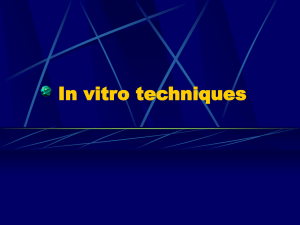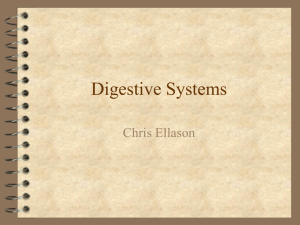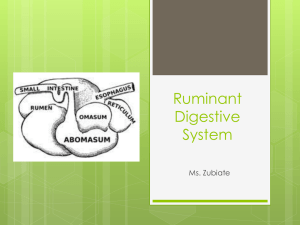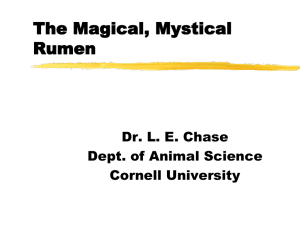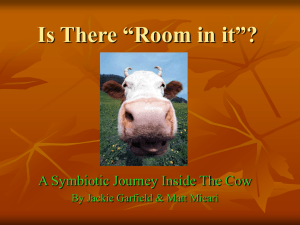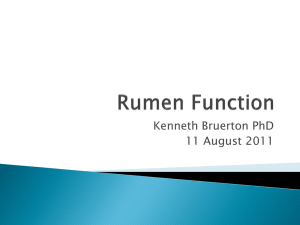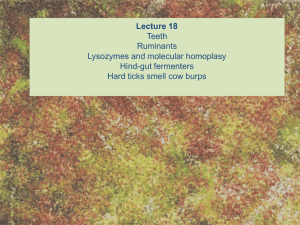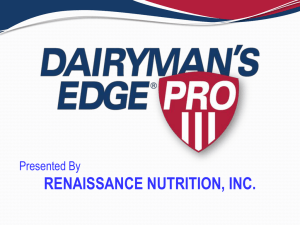CHAPTER 8
advertisement
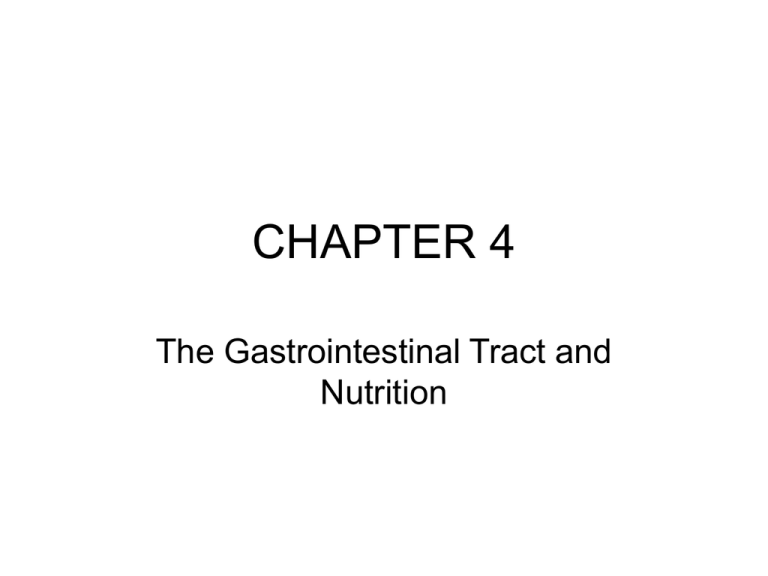
CHAPTER 4 The Gastrointestinal Tract and Nutrition Introduction • Many of the organic components of food are in the form of large insoluble molecules which have to be broken down into simple compounds before they can pass through the mucous membrane of the alimentary cannel into the blood and lymph. The breaking down process is termed digestion, the passage of the digested nutrients through the mucous membrane absorption. Digestion in monogastric mammals • GI tract = gastrointestinal tract • Digestion: mechanical forces – chemical action – hydrolysis of ingesta • Absorption: – small molecules from lumen → – mucosal surface → – blood, lymph • monogastric (nonruminant) , ruminant. • Carnivores: – relatively short and uncomplicated intestine: dog, mink. • Omnivores: – long small intestine, moderately caecum and a sacculated large intestine. • Coprophagy (feces eating) : • rabbit – soft feces, hard feces – supply of vitamins and amino acid GI tract of nonruminant • Stomach: • 1. oesophagus region: – no gland, α-amylase activity continue, active microbial population (mainly Lactobacillus, Streptococci) • 2. cardia region: – produce gel- forming glycoprotein(mucus), protecting the stomach, • 3. fundus gland region: – peptic cells produce proteolytic enzyme, parietal cell secrete HCl • 4.pyloric region: – like those in the cardia region. • Gastric juice – water, – pepsinogen, – inorganic salts – mucus – HCl – intrinsic factor. • Four pepsins have been found in the pig which have optimum pH with 2.0 and 3.5. Pepsin preferentially attack those peptide bonds of aromatic amino acids, (phenylalanine, tryptophan, and tyrosine). Rennin or chymosin are also occur in the gastric juice. Small intestine and digestion 1. duodenum: – covered with finger like, or plate or tongue like villi, brush border enzyme. – The duodenum is the site for mixing digesta and secretion and the jejunum being the site of absorption. • 2. jejunum • 3. ileum • Bile is secreted by the liver and passes to the duodenum through the bile duct. It contains the sodium and potassium salts of bile acids, chiefly glycocholic and taurocholic, phospholipids and bile pigments. • The bile salts play an important part in digestion by activating lipase and emulsifying fats. • Pancreas is a gland which lies in the duodenal loop and two secretory functions. ( Insulin and digestive enzymes) Secretion stimulate route: • Acid enter the duodenum→ • secretin is liberated from the epithelium of the small intestine into blood → • when it reach the pancreatic circulation, stimulates the pancreatic cells to secrete a water fluid containing bicarbonate ions and little enzyme. • Cholecystokinin(CCK) is liberated from the mucosa when peptides and other digestive products reach the duodenum.→ • CCK stimulates the secretion of proenzyme into pancreas juice. pancreas juice • proenzyme such as trypsinogen chymotrypsinogen • Procarboxypeptidases A and B • proelastase, • α-amylase • lipase • lecithinases • nucleases • The inactive zymogen is converted to the active enzyme by enterokinase, an enzyme liberated from the duodenal mucosa. • Digestion in the small intestine include – lumen digestion. – membrane digestion. • The hydrolysis of oligosaccharides to monosaccharides and of small peptide to amino acids is brought about by enzyme associated with the intestinal villi. (called brush border enzymes) • Enzymes produced are sucrase, maltase, lactase , oligo-1,6-glucosidases, and aminopeptidase. Large intestine and digestion • Absorption of water • secretion of inorganic element • Extensive bacterial fermentation , Slow rate of passage and abundant nutrient sources encourage the prolific growth of bacteria. • Cecum, colon,rectum • • • • • Bacteria: Indole, skatole phenol, H2S amines, NH3, volatile fatty acids(VFA , include acetic acid, propionic acid, butyric acid), • H2, B vitamins. GI tract of avian (fowl) • • • • • • • crop: fermentation (lactobacillus) proventriculus: gastric juices gizzard: small intestine: enzyme Cecum(ceca): bacterial fermentation colonic – recturm The digestive enzyme secretion are similar to those of mammals. But lactase not been detected. Absorption of digested nutrients • The duodenum has villi is primarily a mixing and neutralizing site and the jejunum is the major absorptive site. • Role of the GI tract in transport of nutrients • The passage route of nutrients from the intestine lumen into the intestinal epithelial cell and then into the blood or lymph by active, passive transport. • Passive transport : – passive diffusion(high concentration toa low concentration diffusion) – facilitative transport (carrier transport the molecule down its concentration gradient). • Active transport: – the carrier has two specific binding sites and the nutrient is attached to one of these while other site picks up a sodium(in case of monosaccharides and amino acids) or a hydrogen ion (in case of dipeptides). – Sodium pump. – Na/K transporting ATPase. • pinocytosis ( cell drinking), phagocytosis • pinocytosis occurs in new born animal to absorption of immunoglobulins, proteins , peptide from colostrum. *transport route 1. 2. 3. 4. penetration of the microvillus migration through the cell interior possible metabolism within the cell extrusion from lateral and basal of the cell 5. passage through the basement membrane 6. penetration through the epithelium into blood or lymph. Blood and Nutrition • Blood is the vehicle for transport of nutrients and metabolites among organs, tissues and cells of the body, Nutrients transport by carrier or binding protein. GI tract of ruminant 1. Saliva: – 150L (cow), 10L(sheep), eating and ruminating produced. – Provide a source of N (urea and mucoproteins). P, Na, Buffered – maintaining a pH in the rumen 2. Stomach (rumen, reticulum, omasum, and abomasum) . • Rumen: – high population of microorganism(1010 – 1012)fermentation. • Reticulum: – moving food into rumen or into the omasum • Omasum: – reducing particle size, control passage of ingesta. • Abomasum: – glandular stomach • The reticulo-rumen provides a continuous culture system for anaerobic bacteria, protozoa and fungi. • Food and water enter the rumen and the food is fermented to yield volatile fatty acids, microbial cells and gas methane and carbon dioxide. • The acids produced by fermentation are capable of reducing the pH of rumen liquor to 2.5-3.0, but under normal condition the pH is maintained at 5.5-6.0. • reticular groove ( esophageal groove) – Begins at the lower end of the esophagus and, when closed, forms a tube from the esophagus into the omasum. – Allow milk bypass the reticulorumen, and escape bacterial fermentation. – It is stimulated by the sucking, certain ions, solid in liquid • rumination: – semi-liquid materials regurgitate up the esophagus, swallowed the liquid, and remastication of and swallowed the bolus. – 8h/day – inhibition of rumination result reduced in feed intake • Eructation: • contraction of the upper sacs of the rumen which force the gas forward and allow the gas to escape. Rumen microorganisms • The bacteria number 109-1010 per mL of rumen contents.Over 200 species have been identified. • Typical rumen bacteria showed in Table 8.3 • Protozoa are present in small numbers (10 6 per mL), being lager, may equar the bacteria in total mass. Fungi • strictly anaerobic. • The fungi are capable of utilizing most polysaccharides • many soluble sugars, but not use the pectin, polygalacturonic acid, arabinose,fucose, mannose and galactose. • As the microbial mass synthesized in the rumen provides about 20 % of the nutrients absorbed by the host animal, the composition of microorganisms is important. • The bacteria dry matter contains about 100 g/kg, but only 80 % of this is in the form of amino acids, the remaining 20% being present as nuclic acid N. • Some of the amino acids are contained in the peptidoglycan of the cell wall membrane and are not digested by the host animal. Digestion of carbohydrates • All the carbohydrates, but not lignin, are attacked by the rumen microorganism. • The breakdown of carbohydrates in the rumen may be divided into two stages: • First stage: – Digestion of complex carbohydrates to simple sugars (brought by extracellular microbial enzymes). That as analogous to the digestion of carbohydrate in non-ruminants.(Fig. 8.2) • Second stage: • The pathways involved are similar to those in the metabolism of carbohydrates by the animal itself.(Fig 8.3) • Three volatile fatty acids – acetate 65%, propionate 21%, butyrate 14%. • The total weight of acids produced may be as high as 4 kg per day in cows. • Much of the acid produced is absorbed directly from – rumen, reticulum, omasum, • 20% may pass through the abomasum and be absorbed in the – small intestine. • The rate of gas production in the rumen may exceed 30 L/hour. It include – 40% CO2, 30-40% methane, H2 5%, small amount of O2 and nitrogen. • Most of the gas produced is lost by eructation, if gas accumulates it causes bloat, in which the distension of the rumen may be result in the collapse and death of the animal. Digestion of protein • The digestion of protein in the rumen is shown in Fig.8.4. • Food proteins are hydrolysed to peptides and amino acids by rumen microorganisms, but some amino acids are degraded further, to organic acids, ammonia and carbon dioxide. • The ammonia together with some small peptides and free amino acids is utilized by the rumen organism to synthesis microbial protein. • Some of the microbial protein is broken down in the rumen and its nitrogen is recycled. Utilisation of NPN compounds by the ruminant • Dietary protein is not the only contributor to the ammonia pool in the rumen. As much as 30% of the nitrogen in the ruminant foods may be in the form of simple organic compounds such as nitrates and amines or nitrates. Most of these are readily degraded in the rumen, and nitrogen entering the ammonia pool. • Urea in the rumen is rapidly hydrolysed to ammonia by bacterial urease. This NH3 to be efficiently incorporated in microbial source of energy for protein synthesis). It protein. (must have a readily available is important to avoid over consumption of urea, since a rapid absorption of NH3, hence increase blood NH3 concentration to toxic level. Digestion of lipids • The TG present in the foods contain a high proportion of the C18 polyunsaturated acids be hydrolysed in the rumen by bacterial lipase. Unsaturated fatty acids are hydrogenated to monoenoic acid and to stearic acid. • The capacity of rumen microorganisms to digest lipids is strictly limited. If fat level increase above 100 g/kg, the fermentation activity of the microbes are reduced. • Synthesis of vitamins : • vitamin B complex and K. • vit B12 will need sufficient Co. Dynamics of digestion in the ruminant • Food enter rumen→ 1. soluble constituents (sugars) are quickly degraded by the microbes. 2. insoluble constituents are colonized by microbes and slowly broken down. 3. the component will consist of cell wall encrusted with lignin or silica as to be undegradable in the rumen. • The movement of digesta from the rumen (the particale size is to be 3-4 mm) can be expressed as a rate of passage or retention time. • Typical rates of passage of particular matter are 0.012-0.030 per hour, and retention times, 30-80 hours. Control and modification of rumen fermentation • Alter the pattern of digestion that should improve the nutrition of ruminants. • 1. To modify the microbial population in order to suppress undesirable process( methane production) or desirable process( microbial protein). Microbial population, genetic modified bacteria, change protozoa population. • 2. To protect nutrients from rumen fermentation in order that they should be digested in the small intestine.( control of rumen fermentation). Based on heat treatment, chemical treatment . By-pass carbohydrate or protein. • Need to synchronise the supply of energy and protein to the microorganism. For example, to supplement a rapidly degraded source of protein with a rapidly degradable source of carbohydrate . Alternative sites of microbial digestion • The microbial fermentation in the large intestine is similar to that in the rumen. VFA are produced and absorbed, methane and other gas are present.In general, hind gut fermentation is less effective than rumen digestion, many of the product of digestion are not absorbed. • Practising coprophagy (the consumption of faeces) in rabbits. • Poultry have two caeca and a colon in which to ferment residues, they gain little of nothing from hind gut fermentation. Blood evaluation in nutrition • Anemia: – Develop as a result of deficiencies of Fe, Cu, Co, Vit B12, folic acid, or protein – Confoirmed by • Presence of low PCV, • low hemoglobin content in blood, • Microscopic exam of red cells • blood component assay 73 •As the rate of migration of the enterocytes up the villi increases, the enterocytes are shed from the top of the villi at a greater rate; therefore, the number of mature enterocytes decreases. 74

